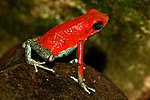serve functions in addition to mimicry; indeed, it is unclear whether they actually mimic eyes. There is evidence that eyespots in butterflies are antipredator...
26 KB (2,973 words) - 07:54, 11 September 2024
'tails' or eyespots on their wings that mimic their own heads, misdirecting predator dupes to strike harmlessly. Many other types of mimicry exist. Use...
70 KB (7,696 words) - 07:58, 29 August 2024
Eyespot can mean: Eyespot (mimicry), a color mark that looks somewhat like an eye Eyespot, a sensory organ of invertebrates; see simple eye in invertebrates...
1 KB (115 words) - 11:53, 25 August 2021
Müllerian mimicry is a natural phenomenon in which two or more well-defended species, often foul-tasting and sharing common predators, have come to mimic...
33 KB (3,605 words) - 12:10, 9 August 2024
visible next to the hamsa. Eye of Providence God's eye Evil eye Darśana Eyespot (mimicry) Görece, Menderes Hamsa Namkha Nazar battu Mezuzah Skandola Ta'wiz...
8 KB (912 words) - 19:42, 21 August 2024
off the evil eye, especially in the form of a pin placed on infants Eyespot (mimicry) – as found in living organisms Fatima's hand – a palm-shaped amulet...
61 KB (7,423 words) - 05:01, 19 September 2024
coincident Eyespot (mimicry) Mimicry Structural coloration Underwater camouflage Related topics Animal senses Blindness in animals Eyespot apparatus Feature...
20 KB (2,385 words) - 18:31, 5 June 2024
and low-profile life.[citation needed] Anasyrma Azusa yumi Exorcism Eyespot (mimicry) Hama yumi Hamsa Hoko (doll) Jack-o'-lantern Mezuzah Noa-name – Word...
28 KB (3,253 words) - 12:39, 18 September 2024
In evolutionary biology, mimicry in vertebrates is mimicry by a vertebrate of some model (an animal, not necessarily a vertebrate), deceiving some other...
27 KB (3,371 words) - 15:36, 13 August 2024
coincident Eyespot (mimicry) Mimicry Structural coloration Underwater camouflage Related topics Animal senses Blindness in animals Eyespot apparatus Feature...
55 KB (6,713 words) - 04:38, 17 September 2024
lamprey has well-developed eyes, while the hagfish has only primitive eyespots. The ancestors of modern hagfish, thought to be the protovertebrate, were...
66 KB (7,902 words) - 15:28, 23 March 2024
Automimicry (redirect from Browerian mimicry)
In zoology, automimicry, Browerian mimicry, or intraspecific mimicry, is a form of mimicry in which the same species of animal is imitated. There are...
17 KB (1,964 words) - 21:50, 2 December 2023
Animal coloration (category Mimicry)
signal their sexual status to other members of the same species; and in mimicry, taking advantage of the warning coloration of another species. Some animals...
49 KB (5,274 words) - 15:11, 25 August 2024
most notable feature of the moth is its large, purplish eyespots on its two hindwings. The eyespots give it its name – from the Greek myth of the cyclops...
10 KB (1,150 words) - 06:43, 21 August 2024
responses to the eyespot stimuli lend support to the eye mimicry hypothesis as they indicated that the avian predator sensed that the eyespots belonged to...
22 KB (2,159 words) - 16:40, 14 April 2024
Saddleback caterpillar (section Mimicry)
Thomas John; Sherratt, Thomas N. (2013-08-01). "Defensive posture and eyespots deter avian predators from attacking caterpillar models". Animal Behaviour...
20 KB (2,226 words) - 04:15, 8 September 2024
coincident Eyespot (mimicry) Mimicry Structural coloration Underwater camouflage Related topics Animal senses Blindness in animals Eyespot apparatus Feature...
19 KB (2,503 words) - 08:40, 12 July 2024
Müllerian mimicry. Giant swallowtail caterpillar everting its osmeterium in defence; it is also mimetic, resembling a bird dropping. Eyespots of speckled...
100 KB (9,850 words) - 13:19, 30 August 2024
Predation (section Camouflage and mimicry)
and cut up their prey. Other adaptations include stealth and aggressive mimicry that improve hunting efficiency. Predation has a powerful selective effect...
109 KB (11,576 words) - 06:25, 19 August 2024
Aposematism (section Mimicry)
Wallace's concept of warning coloration. Aposematism is exploited in Müllerian mimicry, where species with strong defences evolve to resemble one another. By...
52 KB (5,661 words) - 12:46, 11 August 2024
Limenitis arthemis (section Batesian mimicry)
cosmopolitan genus Limenitis. It has been studied for its evolution of mimicry, and for the several stable hybrid wing patterns within this nominal species;...
32 KB (3,739 words) - 13:05, 28 August 2024
Callosamia promethea (section Mimicry)
overlap in activity for a few hours in the early evening. The males use mimicry of the poisonous pipevine swallowtail butterfly as a form of protection...
14 KB (1,631 words) - 20:01, 26 May 2024
Deilephila elpenor (section Eyespots)
defensive posture emphasises the eyespots and makes it more conspicuous. Some research have suggested that this allows the eyespots of the caterpillar to resemble...
23 KB (2,698 words) - 15:47, 30 August 2024
Research by Martin Stevens et al. (2008), however, suggests that eyespots are not a form of mimicry and do not deter predators because they look like eyes. Rather...
9 KB (844 words) - 12:41, 11 August 2024
Deception in animals (category Mimicry)
deception in animals. At the first level, as with protective mimicry like false eyespots and camouflage, the action or display is inbuilt. At the second...
38 KB (4,773 words) - 10:04, 16 September 2024
Defense in insects (category Mimicry)
context of geographic sympatry. Mimicry is divided into two parts, Batesian mimicry and Müllerian mimicry. In Batesian mimicry, an aposematic inedible model...
34 KB (4,153 words) - 07:52, 13 July 2024
threatening or startling behaviour, such as suddenly displaying conspicuous eyespots, so as to scare off or momentarily distract a predator, thus giving the...
53 KB (5,778 words) - 12:39, 11 August 2024
combination of eyespots and osmeterium makes the caterpillar resemble a snake. Since adults are palatable, dark morph females use Batesian mimicry to protect...
27 KB (2,808 words) - 20:47, 3 September 2024
Caudal luring (category Mimicry)
Caudal luring is a form of aggressive mimicry characterized by the waving or wriggling of the predator's tail to attract prey. This movement attracts...
14 KB (1,562 words) - 23:41, 18 September 2024
Underwater camouflage (redirect from Underwater camouflage and mimicry)
decorator crabs; mimicry by animals such as the leafy sea dragon; countershading by many fish including sharks; distraction with eyespots by many fish; active...
24 KB (2,792 words) - 15:27, 28 August 2024

























